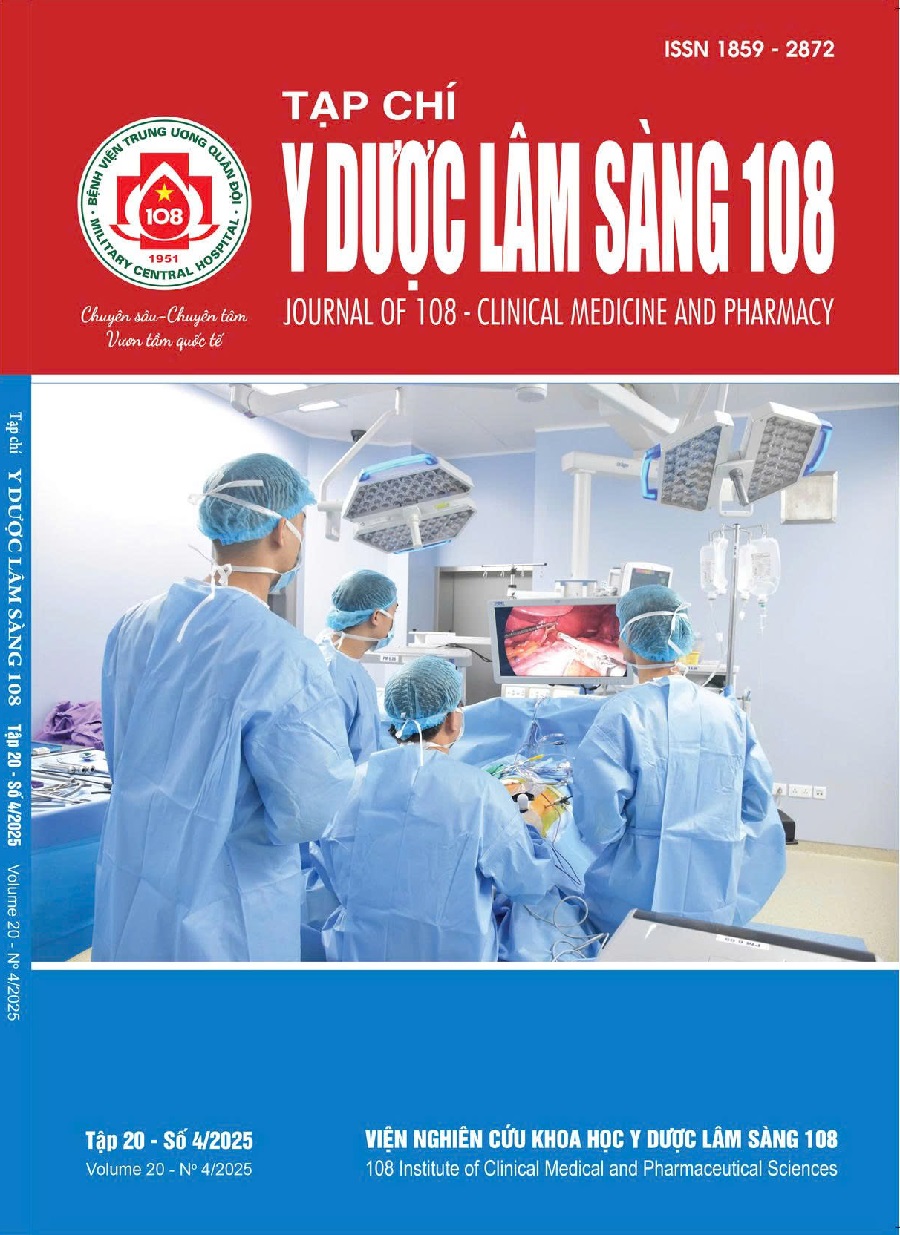Therapeutic outcomes of concurrent chemoradiation following induction chemotherapy for stage III-IVa nasopharyngeal carcinoma
Main Article Content
Keywords
Abstract
Objective: To evaluate outcomes of concurrent chemoradiation post induction chemotherapy for stage III-IVA nasopharyngeal carcinoma patients. Subject and method: A retrospective descriptive study involving 70 patients with stage III-IVA nasopharyngeal carcinoma who underwent induction chemotherapy with 3 cycles of Gemcitabin plus Cisplatin, followed by concurrent chemoradiation from March 2020 to June 2024 at 108 Military Central Hospital and 103 Military Hospital. Response rate (RR), the 3-year locoregional relapse-free survival (LRFS), distant metastasis-free survival (DMFS), disease-free survival (DFS), overall survival (OS) and treatment related adversed events (AEs) were calculated. Result: The complete and partial response rates were 91.4% and 8.6%, respectively. With median follow-up time of 23 months, the 3-year LRFS, DMFS, DFS and OS were 88.6%, 88.6%, 81.4% and 95.7%, respectively. Treatment related grade 1-2 acute AEs were mainly dermatitis (94.3%) and mucositis (90%), grade 3-4 were mostly neutropenia (11.4%); while late AEs were often seen in grade 1 (xerotomia 64.3%, skin atrophy 51.4%). Conclusion: Concurrent chemoradiation post induction chemotherapy for stage III-IVA nasopharyngeal carcinoma patients show good efficacy in terms of response rates as well as high survival rates; with grade 3-4 acute AEs mostly neutropenia and mild late AEs.
Article Details
References
2. Lai SZ, Li WF, Chen L et al (2011) How does intensity-modulated radiotherapy versus conventional two-dimensional radiotherapy influence the treatment results in nasopharyngeal carcinoma patients?. J Radiat Oncol Biol Phys 80(3), 661-668.
3. Al-Sarraf M, LeBlanc M, Giri PG et al (1998) Chemoradiotherapy versus radiotherapy in patients with advanced nasopharyngeal cancer: phase III randomized Intergroup study 0099. J Clin Oncology 16(4): 1310-1317.
4. Chen L, Hu CS, Chen XZ et al (2012) Concurrent chemoradiotherapy plus adjuvant chemotherapy versus concurrent chemoradiotherapy alone in patients with locoregionally advanced nasopharyngeal carcinoma: A phase 3 multicentre randomised controlled trial. The Lancet Oncology 13(2): 163-171.
5. Zhou R, Zhu J, Chen X et al (2020) The efficacy and safety of docetaxel, Cisplatin and fluorouracil (TPF)-based neoadjuvant chemotherapy followed by concurrent chemoradiotherapy for locoregionally advanced nasopharyngeal carcinoma: A meta-analysis. Clin Transl Oncol 22(3): 429-439.
6. Zhang Y, Chen L, Hu GQ et al (2019) Gemcitabine and Cisplatin Neoadjuvant Chemotherapy in Nasopharyngeal Carcinoma. N Engl J Med 381(12): 1124-1135.
7. Pan JJ, Ng WT, Zong JF et al (2016) Proposal for the 8th edition of the AJCC/UICC staging system for nasopharyngeal cancer in the era of intensity-modulated radiotherapy. Cancer 122(4): 546-558.
8. Zhu J, Duan B, Shi H et al (2019) Comparison of GP and TPF neoadjuvant chemotherapy for locally advanced nasopharyngeal carcinoma. Oral Oncology 97: 37-43.
9. Nguyễn Văn Đăng và cộng sự (2024) Kết quả hóa chất dẫn đầu theo sau bởi hóa xạ trị đồng thời ung thư vòm mũi họng giai đoạn III-IVA tại Bệnh viện K. Tạp chí Nghiên cứu Y học 183(10): 270-278.
10. Nguyễn Thị Hoài Thương và cộng sự (2022) Kết quả hóa trị dẫn đầu phác đồ Gemcitabine - Cisplatin ung thư vòm mũi họng giai đoạn III-IV (M0) tại Bệnh viện Ung bướu Nghệ An. Tạp chí Y học Việt Nam 518(2): 190-194.
 ISSN: 1859 - 2872
ISSN: 1859 - 2872
